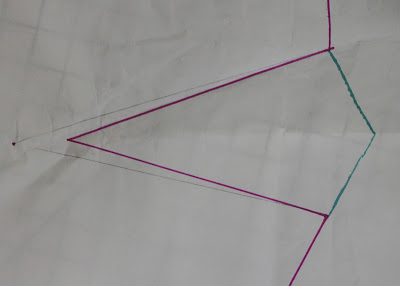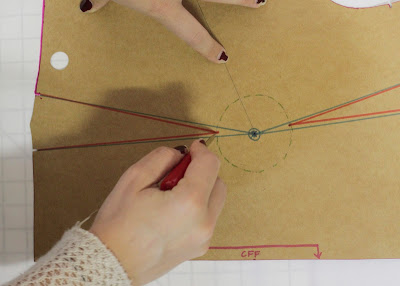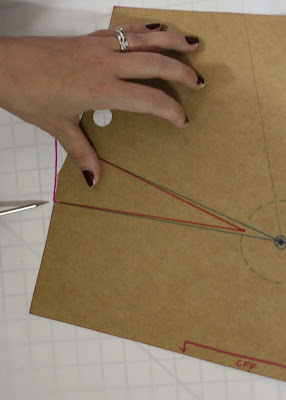Well poke me in the eye with a seam ripper. I can't believe it's been over 2 1/2 months since my last blog post! I blame in part seasons 1-3 of 'The Walking Dead'; what is it about a zombie apocalypse that is so freaking addictive? But mainly I have been a very busy lady.
Here's a quick catch up:
- I just got back from vacationing in Italy (amazing!!) with a six month old child (wow) and bought myself a lot of stunning Italian leather and lace
- I'm currently a judge in the fabulous 'Super Online Sewing Match' hosted by Sew Mama Sew which is absolutely inspiring. Check the competition out if you haven't already!
- I'm also involved with another exciting upcoming project which I can't tell you about yet, but I'm so looking forward to. Oh how sneaky!
- I'm taking part in the Handmaker's Factory Miette Cardigan Knit-A-long and you should too! Yeah that's right, I knit now; like a boss.
- I've made a bunch of clothes that I will be posting about soon.
- Just completed a short course in Pattern Making and absolutely loved it! I am a little bit in love with Kate the teacher who knows her shiz.
- And finally, you may have noticed that my blog has been given a bit of a make over!
Tutorial: How to move a dart
One of the simple and effective things that I learnt and loved from my recent course in Pattern Making, is how to move darts and and create design lines without cutting and slashing your pattern. It amazes me how easy this is. Maybe you have a bodice you want to make out of lace and the darts are in a position that interupts the flow of the lace pattern. This tutorial will show you how to move that dart to where ever you choose.
Things you'll need:
- Bodice pattern piece
- Tracing paper
- Pencil and eraser
- Ruler
- Awl
- Tracing wheel
- One Long Island Iced Tea - for pattern making inspiration
- Really old nail polish job. Wow my nails look ah-maz-ing
Let's Do This
Summary
The images below show the original pattern with two darts, and our final pattern with the darts moved into one at the side.
Tracing your original pattern
1. Get your bodice front pattern piece. Trace off a copy if you don't want to mark your original. I have drawn mine onto a piece of cardboard for more stability.
Note: My pattern piece doesn't have seam allowance added yet. I find it easier to see the true shape of the pattern without getting confused with allowances.
2. Find your bust point on your pattern and make a mark there for your reference. The bust point is drawn in blue, and the original darts I have drawn in red.
Tip: If your pattern doesn't have the bust point marked, hold up the pattern piece on yourself or on a dress form and mark with a pen the fullest point of your bust. This will be your bust point. Generally the darts are pointed towards the bust point.
3. Draw a circle around the bust point with a radius of 3cm. You can see mine in green.
Note: The length of the radius is up to you, generally the smaller circle is for a smaller bust and the larger for the fuller bust.
See that lovely circle we just made around the bust point? That's our no-go dart zone. This will make sense soon.
Positioning your new dart
4. On your pattern piece draw a line where you would like your dart to go. Your line will need to start from the edge of the pattern piece and finish at the bust point. I have done mine in pencil.
Tip: If you are moving a dart to a side seam, draw the line on an angle and not horizontally which is more flattering and looks more pleasing to the eye.
5. Place your pattern piece on top of a large piece of blank tracing paper. Mark on your tracing paper where your bust point is.
Starting at the line you have just drawn you are going to trace your pattern piece in one direction, until you come to your first pre-existing dart.
Tip: Keep the pattern piece as steady as you can to avoid distorting the shape. Place a weight over the centre if it helps.

Closing off the original darts
In the next steps we are going to remove the original darts and create our new dart.
6. Once you come to your first dart, mark a notch at the first dart leg for your reference. Using your awl at the apex of your dart carefully pivot your pattern piece until the second leg of the dart lines up with the notch of the first leg.
Tip: If you don't have an awl, you can use a sharp pencil or the point of a fine pair of scissors to act as your pivot tool.

See how the pattern piece has now moved?! You have just closed off that dart!
7. Continue tracing around the pattern piece until you come to you next dart and repeat the process.



Once you have no more darts on your pattern, continue tracing until you come to your dart line that you drew on to your pattern piece and stop.
Completing the new dart
8. Remove your pattern from the tracing paper and have a look! See that big open gape, that's your new dart! (almost)
9. With a pencil and a ruler, draw in your dart legs going all the way into the bust point.
Remember your no-go dart zone? Make a mark at the edge of the bust circle (3cm away from bust point), making sure that it is centred between the two openings.
10. Draw your two dart legs from that new apex to the openings on your pattern piece. This is your new dart! Depending on how close the base of the dart is to the bust point, will determine how long or how wide the dart is. But don't worry, the dart value is still the same.
Tip: Both dart legs should be exactly the same length, so get your ruler and make sure they are the same.


11. Now you will carefully fold one of the dart legs to meet the second so that the dart is closed off. Score the new dart legs with a pen or pencil to make it easy to fold.
Tip: The direction of the dart is up to you, but generally the bulk of the dart is folded towards to the centre of the garment.
Tip 2: By folding your dart you're making the piece 3D. To make it easier to fold, place the apex of the dart on the corner of a table.

12. If traced correctly, your two dart legs should meet so that it becomes one continuous line. With your tracing wheel, trace over the dart edge where the bulk of the paper is folded under.

13. Open up your pattern piece. The dots on your pattern made by your tracing wheel is the finished shape of your dart. Trace over it with a pencil.
Tip: If you don't have a tracing wheel, use an awl or the edge of a pair of scissors to mark along the line instead.

14. Add your seam allowance to your pattern piece and you're done! You now have a new bodice with your measurements, but with the dart in a different spot!
15. It's Long Island Iced Tea time - you're done!
Have fun with your new patterns!

1. Starting the knit-a-long 2. Fabric splurge in Italy 3. My finished knitted sleeve 4. Harry and I on the beach in Italy.
























This comment has been removed by the author.
ReplyDeleteYou're right, the slashing method is a great way to alter a pattern and very accurate. But isn't it great that there are other options! I loved learning this new way, it's a great way to see how your pattern evolves.
DeleteThanks for your comment :)
Hey Julia. Good to see your in the land of patternmaking. Just keep in mind that pivoting is not the golden solution. My students always Slash and Open first as it allows them a visual image to see what is happening to the dart which is an important fitting tool. This way the new dart position can be assessed to see whether it can be incorporated into style lines, tucks or gathers, or into fullness. You must also be careful that when pivoting to certain positions, that you don't end up with a marked point (pointy boobs), too much fullness or even dart arms that have too much fullness running parallel to their edges.(this would never be remedied by shortening the apex from the bust circle). Your dart is a generous one, so consider splitting it into 2 darts at the side seam. A very wide, shortened dart can be problematic.
ReplyDeletePivoting can be a shortcut but only use it spasmodically. Happy patterning !!!!!
Very detailed tutorial, I shall keep it in mind for future reference. Thanks Julia.
ReplyDeleteYou and Harry look lovely in Italy!
Thanks Nessa! :)
DeleteThank you! This is a very straightforward tutorial. I would like to try your method. BTW, I am currently wearing a similar manicure!!
ReplyDeleteAll the kids will be wearing their nails just like it soon. You wait! :)
DeleteThank you for you tutorial! It is very ckear and well illustrated! I keep it in mind for my future projects :)
ReplyDeleteYay! Thanks so much for your comment! :)
DeleteWow! This was so helpful. Your instructions made sense to me!!! I have bookmarked this post to refer back to and plan to give this a try on my next project.
ReplyDeleteThanks so much Linda! Good luck with your next project. Let me know how it goes!
DeleteSo glad you're back with stories from Italy, garments you've made, a new blog design, and a tutorial! You are one rockin lady!
ReplyDeleteSo glad you're back with stories from Italy, garments you've made, a new blog design, and a tutorial! You are one rockin lady!
ReplyDeleteWell thank you very much! I'm glad to be back too :)
DeleteYou're back! Your baby is adorable, love those chubby legs!
ReplyDeleteI've been reading your blog for several months, I really love some of the dresses you've made. I'm using them as inspiration to get sewing again.
Dee
That's so good to hear Dee! Yes my baby is in the 90th percentile for weight ... he sure likes his milk!
DeleteBusy lady! I truly admire women like you who manage to do so many things and being productive! Looking forward to seeing your sewing projects!
ReplyDeleteThat's such a great compliment, thank you! It's good to get back into it all!
DeleteHey, this is a really interesting post and something I will try. I can pattern-make too and will definitely give this a go to see how it works for me.
ReplyDeleteAwesome! Hope it works out for you. Let me know how you go!
DeleteThank you for this wonderful tutorial and for letting us know about this Miette KAL. Do you know that I was already knitting a Miette and that I was planning to finish it by the end of the month? Quite a coincidence! :D
ReplyDeleteAre you serious?!! You must have been tuned into our brain waves! Fantastic work. Looking forward to seeing your knitted Miette!
DeleteItaly sounds fabulous, I've heard the fabric choice there is amazing! The dart tip is really handy, slashing and so forth can be tiresome :)
ReplyDeleteSeriously, I almost collapsed from overstimulation in those fabric stores. It was intense!
DeleteI did tragically fall in love with some fabric however that was 300 Euro. It was SO hard having to walk away!
Hi! Where in Italy you've been? I'm in the north near Venice :)
ReplyDeleteWe were limited to a few places, seeing as we had our son with us! We stayed in Rome, Campobasso (I have family there) Praiano and Florence. Absolutely loved it all!
DeleteOoooh...Florence, so jealous! I've wanted to go there since I was 16 (that's the year we did Renaissance & Baroque in art class - which oddly made a more lasting impression than 4 years of doing a BFA! lol)
DeleteGreat to see you back to blogging Julia!:) I look forward to seeing your new sewing creations, especially with your new lace & leather! Sounds like you had a fantastic trip! :) And P.S, thanks for the tutorial. I'll have to refer back to it!
ReplyDeleteWhy hello again! So good to see you back and busy as ever. Harry's such a heartbreaker in the making. I don't know where you find the energy - something extra in those Long Island Iced Teas?
ReplyDeleteThanks for a great tutorial! Do you know if there is anywhere I could go to find out how to add darts to a pattern that doesn't have any at all? Or is that utter foolishness and I should just get more realistic about what suits my body shapes and buy patterns that have darts included?
ReplyDeleteYour baby is about 70% too cute. I just want to take a bite out of his chubby leg.
ReplyDeleteThis comment has been removed by the author.
ReplyDeleteI have been a fashion teacher and professional pattern maker for close to 25 yrs and almost exclusively use pivoting to move my darts around. If I'm adding volume someplace or drafting a cowl neck for example I might cut and slash, but I've developed a good eye for where I need to add or remove even in pivoting.
ReplyDeleteIt's really about understanding how a garment works and translating the flat to 3D. Play, play, play with this and all techniques to help you find out what works best for you.
Thank you very much for your tutorial!
This comment has been removed by the author.
ReplyDeleteHey Julia, where did you do your pattern-making course? Cheers, Sarah
ReplyDeleteHi Sarah, I did it through RMIT in Brunswick! I recommend it if you're thinking of giving it a go :)
DeleteThanks, Julia, I will check it out!
DeleteThis is a wonderful tutorial. Thank you so much for moving the darts away from the actual bust point/nipple. This is the sign of a quality dart. Unfortunately many newer indie pattern designers don't have this basic fitting knowledge that you have shared here and could take a lesson from you. Great post, Julia. I just found this on Pinterest and it will go on my fitting tutorial board. Worth sharing!
ReplyDelete